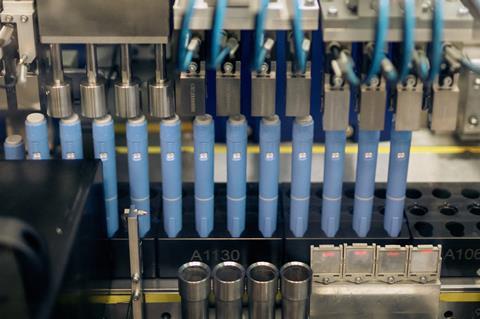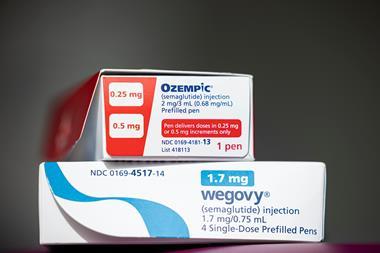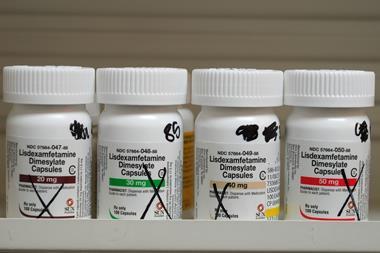There is a gush of investment from drugmakers Eli Lilly and Novo Nordisk as the companies hasten to boost production of their new anti-obesity drugs. Demand for these drugs, which mimic the natural hormone glucagon-like peptide 1 (GLP-1), has rapidly outstripped supply and the leading duo are now trying to keep pace with the predicted market growth for these incredibly valuable drugs.

Earlier this year, Eli Lilly upped its 2024 revenue forecast for its GLP-1 medicines Mounjaro and Zepbound (tirzepatide) by $2 billion (£1.5 billion) to almost $9 billion. Meanwhile, there are predictions that GLP-1 drugs could reach over $125 billion in sales annually for diabetes and obesity by 2033.
If you want to meet the future demand, the time to expand is now
Ivan Lugovoi, Kühne Logistics University
To boost supplies, the two leaders are opting to build up their own internal production capacity. Lilly is to invest $9 billion at a site in Indiana, US, to boost production of tirzepatide. It previously announced expansion at a manufacturing site in Germany, bringing to $11 billion its global manufacturing investments over the past three years.
Similarly, Novo Nordisk announced a $4 billion injection into a US manufacturing facility in North Carolina in June. And its parent company, Novo Holdings, agreed a deal to buy Catalent, a contract drug manufacturing organisation (CDMO), for $16.5 billion with Novo Nordisk expected to acquire three of Catalent’s manufacturing sites to bolster production of its drugs Ozempic and Wegovy (semaglutide), once the deal is finalised.
‘If you want to meet the future demand, the time to expand is now,’ says Ivan Lugovoi, professor of supply chain management at Kühne Logistics University in Hamburg, Germany. It can take three to five years to build, install, validate and qualify a facility to make these drugs. The fill-finish line for pre-filled syringes – needed for the weekly injections of current GLP-1 drugs – are also different from those handling vials and cartridges. ‘You need to have specialised technologies in place to process and move those devices,’ says Gil Roth, president of the Pharma & Biopharma Outsourcing Association in the US.
Expanding their own production lines will give Eli Lilly and Novo Nordisk greater security over supply, and more control over forecast and production volumes. It should also lower costs by improving their manufacturing process. ‘They see this as their main revenue-making drugs, so they want control,’ says Lugovoi. But creating in-house capacity comes with its own risks, and Novo’s Catalent deal is also raising questions about its implications for drug supplies generally.
Supply security
Novo’s purchase of Catalent surprised industry watchers. ‘We haven’t seen very much CDMO capacity becoming captive in-house capacity for a pharma company,’ says Roth. He notes that smaller biopharma companies have often been reluctant to get stuck with bricks and mortar, opting to collaborate with a CDMO. The purchase has also drawn the attention of the Federal Trade Commission (FTC) in the US, however, which has requested additional information on the deal.
I don’t think there are conditions you could put in place to adequately protect consumers
David Balto, Attorney
Politicians and regulators have become increasingly sensitive to drug costs and antitrust issues, and the deal has raised concerns over its potential impact on competition in the pharma industry. David Balto, an attorney and former policy director of the FTC, notes that Catalent is one of only two full service CDMOs in the US, with 87 of the top 100 pharmaceutical manufacturers and 80 of the top biologics relying on it. ‘CDMOs play a vital role, in not only manufacturing, but also in helping the pharmaceutical firms go through the regulatory process,’ says Balto. ‘I don’t think there are any kind of conditions that you could put in place to adequately protect consumers.’
Balto warns that the deal could give Novo Nordisk control over GLP-1 drug supply in particular, allowing it ‘to dictate the terms of competition to its rivals and effectively raise the cost and reduce the availability of these vital drugs’.
Security of supply matters from a business and political perspective now more than ever, and there is pressure on pharma to ensure supply of essential medicines. ‘For politicians, it is very difficult to explain drug shortages,’ says Lugovoi. Yet views on the Catalent deal are mixed. ‘I don’t see problems with this deal,’ Lugovoi adds.
CDMO outsourcing could be further hit by legislation winding its way through the US Congress – the BioSecure Act. This alleges that key Chinese instrument makers and CDMOs have ties to the military. The bill would prohibit US pharma from collaborating with specified Chinese CDMOs by blocking certain government contracts, grants and loans to companies that do business with them.
‘There is growing industry awareness around Biosecure now, and CDMO customers are taking its prospects very seriously,’ says Roth, but he is cautious about predictions. ‘It is a fraught situation right now in terms of understanding what it’s going to mean, how its going to be implemented and what the fallout is going to be,’ he says.
Competition is coming
The spate of investment in manufacturing also signals to any competitors developing their own GLP-1 drugs that this will be a tough market to enter. ‘[Novo and Lilly] are trying to dissuade others to invest by saying we are putting in billions and will have a competitive advantage with our in-house manufacturing,’ says Lugovoi.
Those competitors are already on the horizon. Viking Therapeutics has a GLP-1 drug that also hits another receptor (GIP), which completed a phase 2 trial this year in patients with obesity. It also has an oral version moving into phase 2. Meanwhile, Roche recently announced positive results for a once-daily oral GLP-1. Amgen too is developing its own anti-obesity drug, with phase 1 results published early this year.
It’s a delicate balancing act to get the right supply without over capitalising on capacity
Philip Short, Flagship Asset Management
‘For the next two years, I can see Eli Lilly and Novo holding prices, but prices should start to come down in two to three years as more competition arrives,’ says Philip Short, fund manager at Flagship Asset Management. Once the medicines come off patents early the next decade, prices may fall precipitously.
That creates a risk for pharma investing in production sites that could become obsolete. ‘There is massive investment, but longer term, this market is susceptible to significant change, such as if somebody develops an oral GLP-1,’ says Roth. ‘Similarly, while current versions of GLP-1s are weekly, companies are working on monthly injections.’
Novo Nordisk and Eli Lilly have enormous business incentives to ensure supply chain resilience. They will also hope that their first mover advantage will allow them to capitalise on other treatments that target the GLP-1 receptor, such as positive trial results for reducing sleep apnea and recent reports on semaglutide given to diabetics with chronic kidney disease. Earlier this year, the US Food and Drug Administration approved injections of semaglutide to reduce the risk of heart attacks and stroke.
Nonetheless, it remains challenging for Lilly and Novo to invest the right amount in their own manufacturing facilities. ‘It’s a delicate balancing act to get the right supply now without over capitalising on capacity,’ says Short.

















No comments yet